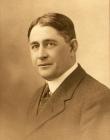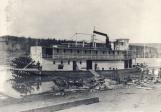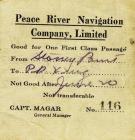1
There are few historical figures of greater importance to the development of the Peace River region than James Kennedy Cornwall, otherwise known as "Peace River Jim". His importance to the region took many forms: promotion of the region; creating business enterprises; taking a politicial role (he was to serve as an MLA) and, most importantly to the topic of steamboats on the Peace River, establishing transportation companies.Cornwall first came to northern Alberta in 1898 as part of the Klondike Gold Rush of that year. Upon arrival he became involved in business activities, most notably creating the trading company called Bredin & Cornwall in 1899 with his partner Fletcher Bredin. His entrepreneural vision for the north included a series of trading posts and stores throughout the Peace and Athabasca River watersheds as well as Lesser Slave Lake. In addition, a key element of his vision was control of the rail and river transportations systems connecting Athabasca Landing (north of Edmonton) to the Peace and Mackenzie River systems.
Note on Sources:
Unfortunately there is no biography of Jim Cornwall. The best description and analysis of his activities related to the Peace River Region is provided in David W. Leonard. The Last Great West: The Agricultural Settlement of the Peace River Country to 1914.
2
"Peace River" Jim Cornwall.Circa 1912-18
 Credits:
Credits:Peace River Museum, Archives & Mackenzie Centre, 81.1194.019
3
Cornwall was to become very familiar with travel on the Peace River as he was a frequent passenger on the Hudson's Bay Company's boats steamboats, the S.S. Peace River and the steam tug Messenger. In 1910, for example, he took on the role of promoter of the Peace River region by taking a group of some 20 journalists, adventurers, scientists and businessmen on the S.S. Peace River, travelling the length of the river from Fort Vermilion to Dunvegan. In showing the potential value of the region to this group he demonstrated that the best way of accessing the area at that time was by steamboat.Note on Sources:
Detailed descriptions of the 1910 expedition can be found in:
L.V. Kelly. North With Peace River Jim.
David W. Leonard. The Last Great West: The Agricultural Settlement of the Peace River Country to 1914.
4
The S.S. Peace River.Circa 1908-1915
Peace River Crossing, Alberta, Canada
 Credits:
Credits:Peace River Museum, Archives & Mackenzie Centre, 81.1197.002
5
To fulfill his vision of creating a vast transportation network linking the Peace, Athabasca and Mackenzie River systems Cornwall established the Peace River Navigation Company in 1915 with his partners George Magar (boat builder and Captain), Campbell Young, Leonard Sawle and L.M. Powers. In doing this Cornwall envisioned the building and operation of steamboats on the Peace River, just as he had with the Northern Transportation Company on the Athabasca River.Cornwall had founded the Northern Transportation Company at Athabasca Landing in 1903 with partners Fletcher Bredin and boat builder J.H. Woods. In addition to building and running scows on the Athabasca River the Company was to become a major builder of steamboats. The latter included: the S.S. Midnight Sun (1903): the S.S. Northern Light (1904); the S.S. Northland Sun (1909); the original S.S. Northland Call (1910);the S.S. Northland Star (1911); the S.S. Northland Echo (1912). Through these steamboats the Northern Transportation Company offered freight and passenger service on the Athabasca River and Lesser Slake Lake. As far as the Peace River the Company could only reach as far upstream as the Vermilion Chutes on the lower river.
Note on Sources:
The most detailed description of the activities of the Northern Transportation Company can be found in Athabasca Historical Society. Athabasca Landing: An Illustrated History.
6
Peace River Navigation Company ticket for travel on the S.S. Northland Call.Circa 1916-1920
 Credits:
Credits:Peace River Museum, Archives & Mackenzie Centre, AR89.7.20
7
The first steamboat built and known as the S.S. Northland Call was built at Athabasca Landing by Cornwall's Northern Transportation Company in 1910. Constructed by J.H. Woods, this steamboat had an exceptionally shallow draft and was designed to deal with all of the rapids on the Lesser Slave River. Woods hoped his design would allow for a boat to go all the way from Athabasca Landing to Grouard without any portages. This was only accomplished once by the S.S. Northland Call in 1913. The decision was made to scrap the boat, saving its engines and drive systems.When the Peace River Navigation company was formed in 1915 a second S.S. Northland Call had been built in the boatyards in West Peace River by George Magar who was also to serve as its Captain. Apparently the name S.S. Northland Call was kept as the new boat utilized the engine and machinery from the original S.S. Northland Call. The new S.S. Northland Call was a stern-wheeler, 100 feet in length with a shallow draft.
In its first season of operation (1915) on the Peace River the S.S. Northland Call, captained by George Magar, sunk after striking a rock which badly damaged her hull. After repairs during the winter of 1915-1916 the S.S. Northland Call was relaunched and was used by the Peace River Navigation Company on the Peace River until 1919. The boat was sold to the Peace River Development Corporation and relaunched in the spring of 1920 following a rebuild. The name of the boat was also changed to the S.S. Hudson's Hope. It would appear that the boat only lasted the 1920 season and was scrapped in 1924.
Cornwall's vision of a water transportation system linking the Peace River to the Athabasca and Mackenzie Rivers proved to be unsuccessful as the S.S. Northern Call was not an effective design.
8
The S.S. Northland Call.Circa 1916-1920
Athabasca River, Alberta, Canada
 Credits:
Credits:Peace River Museum, Archives & Mackenzie Centre, 76.689.007